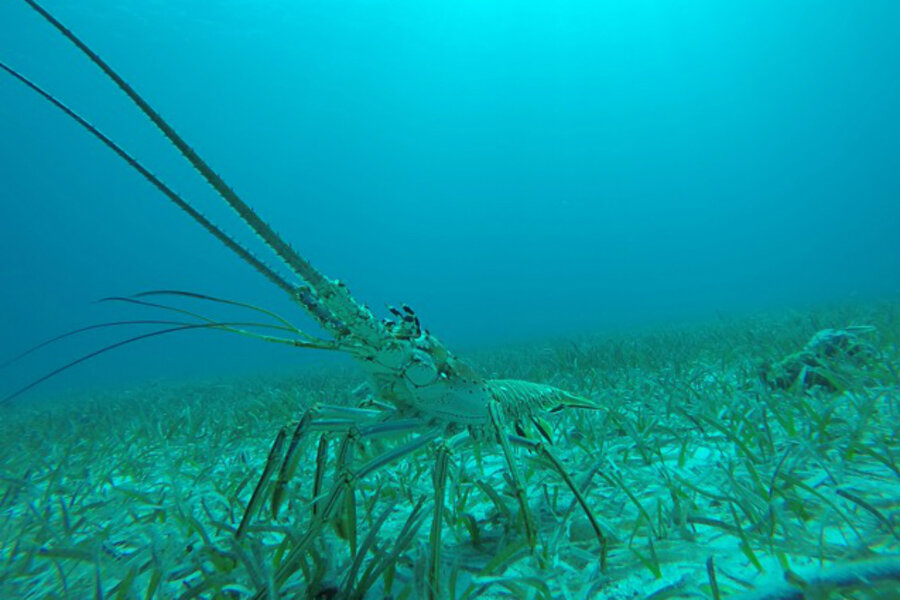Spiny lobsters tap into a strange food source, scientists say
Loading...
In elementary school science class, children learn that the food chain begins with photosynthesis in plants. The leafy organisms convert the energy of sunlight into energy and biomass. Herbivores then munch on the plants, and carnivores, in turn, eat those vegetarians. The whole process transfers that sunlight energy into biomass up the food chain. It seems pretty simple, right?
It turns out, an alternative food production process may actually play a more significant role in food webs than previously thought, scientists say, complicating the picture. In chemosynthesis, bacteria get their energy from chemicals in their environment – not from sunlight. And some of that energy may end up in the food on humans' plates too.
Researchers studying deep-sea vents saw animals deriving sustenance from these chemosynthetic bacteria but thought that the process was a bit of a dead end in shallower environments. But a new study of spiny lobsters living the shallow waters of the Bahamas found that they, too, have been tapping into a chemosynthetic food source.
The Caribbean spiny lobster, Panulirus argus, snacks on pretty much anything, study lead author Nicholas Higgs, a marine biologist at Plymouth University in Devon, England, tells The Christian Science Monitor in a phone interview. The crustaceans have been known to snack on snails, sea stars, sea cucumbers, algae, and even the occasional seahorse or sea sponge.
Lucinid clams, which are known to derive energy from a symbiotic relationship with chemosynthetic bacteria, also make it into these lobsters diet. So Dr. Higgs and his colleagues decided to investigate just how much of the lobsters' diet came from chemosynthetic production.
And it turns out the lobsters are getting about a fifth of their food from outside the traditional photosynthesis-based food chain, the researchers report in a paper published Thursday in the journal Current Biology.
Here's how it works: The lucinid clams live deep in the sediment beneath seagrass beds. The symbiotic bacteria that live in their gills converts chemical compounds in the those sediments into food for themselves and their hosts, the clams.
Higgs isn't quite sure how the lobsters get to these clams, as the lobsters live on the seafloor and the clams live about half a foot below it, but they do. And when they crack open the clams' shells, they tap into this extra source of food that wouldn't exist if it weren't for chemosynthesis.
Then along come fishermen that collect the lobsters, which generate over $450 million each year, and humans get some of this chemosynthetic-based energy too.
"They're ultimately adding food into the food chain," Higgs says.
Higgs and his colleagues examined the tissues of the lobster to look for stable isotope signatures of these lucinid clams to determine just how much the crustaceans were eating. In the process, they found that another animal may also be munching on the chemosynthesis-fed clams: moon snails.
"We only sampled a handful of them because we were mainly just looking at them as a food source for the lobsters, which they definitely are," Higgs says, "but when we ran the chemical analysis, some of these moon snails had a chemical signature that completely overlapped with the chemosynthetic clams."
More research will be needed to figure out if the snails are actually eating the clams, he says, but bore holes in the clams' shells that match the snails' predation style corroborate that story.
The Bahamas aren't the only place where the lucinid clams introduce extra food into the food chain. Research in Mauritania suggests that birds overwintering in the region also munch on these clams, making it so the region can support more birds than would be expected if the food web was only based in photosynthesis.
Chemosynthesis isn't an entirely separate process from photosynthesis, notes Robert Carney, a deep sea ecologist at Louisiana State University whose own research has focused on chemosynthetic systems but who was not part of this research. The chemicals in the sediments that the bacteria use come from plant material that is rotting, in this case the seagrass growing in the sands above where the lucinid clams live.
"So the energy actually traces back to photosynthesis," he tells the Monitor.
These findings probably won't change anything for the lobster fisheries in the Bahamas, Higgs says. The fishermen have always known that placing artificial shelters to mimic the lobsters' preferred reef habitat in the seagrass beds increased their yield, he says. "What this shows is that the reason that's the case is that these clams are particularly associated with the seagrass."
But, Higgs adds, it's exciting to learn something new about the Caribbean spiny lobster because the species has been thoroughly studied in the past. It shows "there's always new things to find out even when you think it's all been done."








